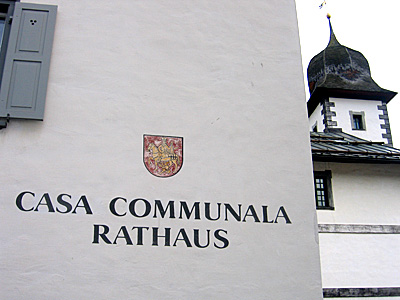Romansh revels in language status

Why is Romansh - spoken by 0.5 per cent of the Swiss population - considered a language, whereas Swiss German, spoken by almost 64 per cent, is classed as a dialect?
The answer lies not only in linguistics, but also in issues of culture, identity and politics.
Swiss German is a German dialect used on an everyday basis by the majority of people in Switzerland.
High, or standard, German is learned in schools and used as a written language. But it is so different to Swiss dialect that many pupils find it almost like learning a foreign language.
It therefore seems strange that Romansh, which is only spoken in the southeastern canton of Graubünden, is classified a national and official language, while Swiss German is not.
Romansh has a long history and has been considered a language by linguists since the mid 19th century.
“Romansh kept the use of ‘s’ in the plural, which is not the case in any Italian dialect,” Romansh expert Chasper Pult told swissinfo.
“This also applied in France and Spain, but Romansh was not in contact with these regions. So the linguistic criterion is pretty convincing here.”
Opposition
Nevertheless, there was some opposition to Romansh being considered a language, and this came to a peak during the First World War and the fascist era in Italy.
At the time Italian linguists regarded Romansh as a dialect close to Alpine Lombard, and therefore a relation of Italian.
But even Italy found it hard to place Dolomitic Ladin and Friulian, Rhaeto-Romance variants from the north of the country and sister languages to Romansh.
Yet linguistics alone was not enough to give Romansh its language status.
“Once linguists had prepared the ground by noting the linguistic specifics of Romansh, there was a cultural renaissance, a movement which led to the recognition of Romansh as the fourth national language in 1938,” said Pult.
Added to this was the fact that the five different variants of Romansh that developed in Graubünden were already standardised through translations of the Bible, literature and schoolbooks, says Georges Lüdi, a professor of languages at Basel University.
“The problem was that these standardised variants covered a territory that was far too small to be really viable. Therefore the variants were recognised as one whole language, but it was accepted that each variant had its own spelling and pronunciation.”
Swiss German
Could not these criteria also be applied to Swiss German, especially as the differences between Germany and Switzerland are not only linguistic but also cultural?
“In the German-speaking area, the standardisation process started during the Reformation. Luther and Zwingli were the driving forces behind this, so that everyone could read the Bible,” Lüdi told swissinfo.
“There was therefore a movement towards a homogenisation of written German. German-speaking Switzerland participated in this and a consensus was established from north to south.
“In the 17th century, the Germans started speaking this variant but Switzerland did not. This effectively means the Germans started to speak as they wrote, while the Swiss started to speak and write differently.”
Dutch is essentially a German dialect which has become the national language of the Netherlands. Could a similar thing happen with the Swiss German dialects?
“The Swiss German identity comes from the fact that people from Lucerne or Bern speak differently and that therefore there is a Lucerne or Bern identity but not really a Swiss German one,” said Lüdi.
“To have something like Dutch, you’d have to standardise these dialects, and nobody wants that.”
Lüdi added that Swiss German dialects were in no way comparable to the Romansh idioms.
“There used to be five standard Romansh languages, but no standard written form, whereas for Swiss Germans, German is the standard written version.”
In this context, the recent creation of a standardised Romansh – Rumantsch Grischun – may prove to be for the five Romansh variants what German is to the Swiss German dialects.
swissinfo, Bernard Léchot
According to the 2000 census:
Switzerland has around 7.3 million inhabitants.
63.7% speak German, 20.4% French, 6.5% Italian and 0.5% (or 35,095 people) Romansh.
Several non-national languages have more speakers than Romansh, including Serbian and Croatian (1.5%), Albanian (1.3%), Portuguese (1.2%), Spanish (1.1%,) English (1%) and Turkish (0.6%).
Romansh is made up of five idioms linked to an area of Graubünden: Sursilvan (anterior Rhine), Sutsilvan (posterior Rhine), Sumiran (central Graubünden), Puter (Upper Engadine) and Vallader (Lower Engadine and Val Müstair). A standard version, Rumantsch Grischun, has existed since 1982.
Swiss German dialects are divided into three groups: Low Alemannic (Basel), High Alemannic (Swiss lowlands) and Highest Alemannic (Alps). Unlike most other dialects, they are spoken in all levels of society and are used in both cities and the countryside.

In compliance with the JTI standards
More: SWI swissinfo.ch certified by the Journalism Trust Initiative
You can find an overview of ongoing debates with our journalists here. Please join us!
If you want to start a conversation about a topic raised in this article or want to report factual errors, email us at english@swissinfo.ch.